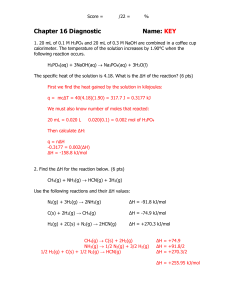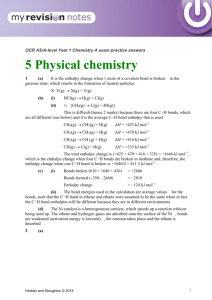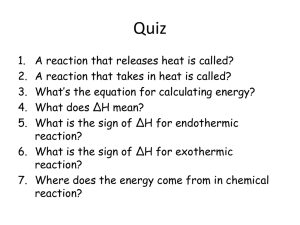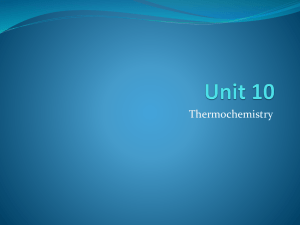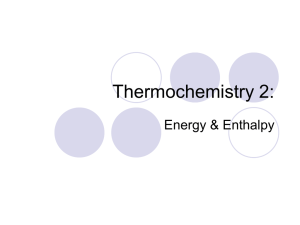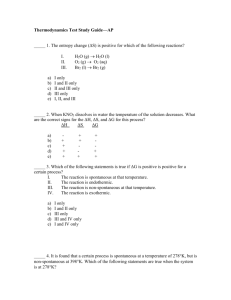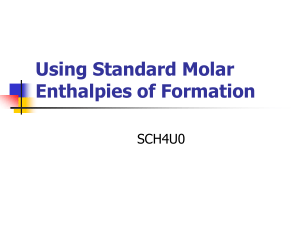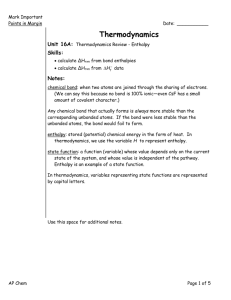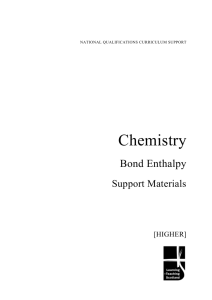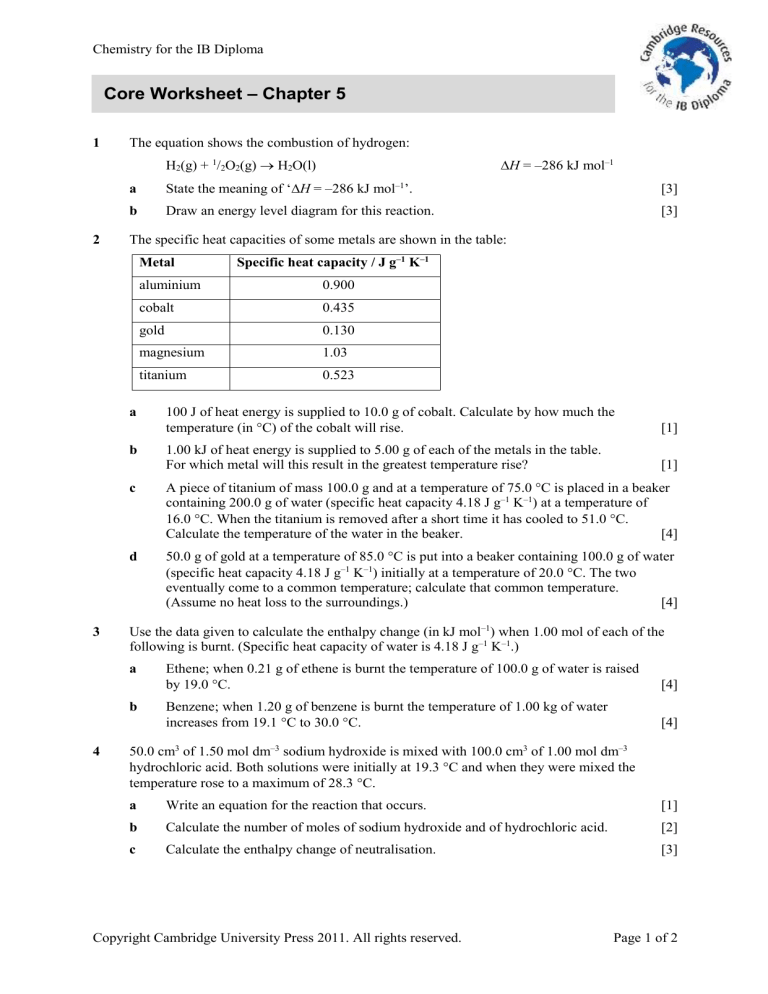
Chemistry for the IB Diploma
Core Worksheet – Chapter 5
1
The equation shows the combustion of hydrogen:
H2(g) + 1/2O2(g) H2O(l)
2
a
State the meaning of ‘H = –286 kJ mol–1’.
[3]
b
Draw an energy level diagram for this reaction.
[3]
The specific heat capacities of some metals are shown in the table:
Metal
a
b
3
Specific heat capacity / J g–1 K–1
aluminium
0.900
cobalt
0.435
gold
0.130
magnesium
1.03
titanium
0.523
100 J of heat energy is supplied to 10.0 g of cobalt. Calculate by how much the
temperature (in C) of the cobalt will rise.
[1]
1.00 kJ of heat energy is supplied to 5.00 g of each of the metals in the table.
For which metal will this result in the greatest temperature rise?
[1]
c
A piece of titanium of mass 100.0 g and at a temperature of 75.0 C is placed in a beaker
containing 200.0 g of water (specific heat capacity 4.18 J g–1 K–1) at a temperature of
16.0 C. When the titanium is removed after a short time it has cooled to 51.0 C.
Calculate the temperature of the water in the beaker.
[4]
d
50.0 g of gold at a temperature of 85.0 C is put into a beaker containing 100.0 g of water
(specific heat capacity 4.18 J g–1 K–1) initially at a temperature of 20.0 C. The two
eventually come to a common temperature; calculate that common temperature.
(Assume no heat loss to the surroundings.)
[4]
Use the data given to calculate the enthalpy change (in kJ mol–1) when 1.00 mol of each of the
following is burnt. (Specific heat capacity of water is 4.18 J g–1 K–1.)
a
b
4
H = –286 kJ mol–1
Ethene; when 0.21 g of ethene is burnt the temperature of 100.0 g of water is raised
by 19.0 C.
[4]
Benzene; when 1.20 g of benzene is burnt the temperature of 1.00 kg of water
increases from 19.1 C to 30.0 C.
[4]
50.0 cm3 of 1.50 mol dm–3 sodium hydroxide is mixed with 100.0 cm3 of 1.00 mol dm–3
hydrochloric acid. Both solutions were initially at 19.3 C and when they were mixed the
temperature rose to a maximum of 28.3 C.
a
Write an equation for the reaction that occurs.
[1]
b
Calculate the number of moles of sodium hydroxide and of hydrochloric acid.
[2]
c
Calculate the enthalpy change of neutralisation.
[3]
Copyright Cambridge University Press 2011. All rights reserved.
Page 1 of 2
Chemistry for the IB Diploma
5
Given these enthalpy changes:
CH3CH2CH2OH(l) + 9/2O2(g) 3CO2(g) + 4H2O(l)
Ho = –2010 kJ mol–1
CH3CH2CH2OH(g) + 9/2O2(g) 3CO2(g) + 4H2O(l)
Ho = –2055 kJ mol–1
calculate the enthalpy change for the following process:
[2]
CH3CH2CH2OH(g) CH3CH2CH2OH(l)
6
Given these enthalpy changes:
Xe(g) + F2(g) XeF2(g)
Ho = –100 kJ mol–1
Xe(g) + 2F2(g) XeF4(g)
Ho = –200 kJ mol–1
calculate the enthalpy change for the following process:
[2]
XeF2(g) + F2(g) XeF4(g)
7
Define, using an equation, the bond energy of H–Br.
8
Use the bond energies given in the table to calculate enthalpy changes for reactions below.
9
Bond
Bond enthalpy
/ kJ mol–1
Bond
Bond enthalpy
/ kJ mol–1
Bond
C–C
348
C–H
412
C–O
360
C=C
612
N–H
388
C=O
743
CC
837
O–H
463
CO
1070
N–N
163
O–O
146
Cl–H
431
N=N
409
O=O
496
NN
944
H–H
436
Bond enthalpy
/ kJ mol–1
a
C2H4(g) + 3O2(g) 2CO2(g) + 2H2O(g)
[5]
b
CO(g) + 3H2(g) CH4(g) + H2O(g)
[5]
c
4NH3(g) + 3O2(g) 2N2(g) + 6H2O(g)
[5]
Use the data given below and the bond energies in question 8 to calculate the
Cl–Cl bond energy.
4HCl(g) + O2(g) 2H2O(g) + 2Cl2(g)
10
[1]
[5]
Ho = –112 kJ mol–1
Given these enthalpy changes:
MgCl2(s) Mg2+(g) + 2Cl–(g)
Ho = +2490 kJ mol–1
Mg2+(g) Mg2+(aq)
Ho = –1920 kJ mol–1
Cl–(g) Cl–(aq)
calculate the enthalpy change for the following process:
Ho = –360 kJ mol–1
[4]
MgCl2(s) MgCl2(aq)
Copyright Cambridge University Press 2011. All rights reserved.
Page 2 of 2

